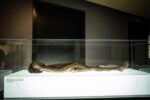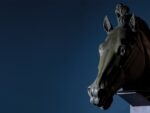Koo Jeong A. – Stars Above the Tree
.jpg)
Lo spazio in relazione all’immaginario architettonico, il mondo in relazione alle tematiche più profonde sulla Terra, l’universo in relazione alla dimensione N” ha scritto Koo Jeong A rispetto ai dipinti su tela di lino che presenterà nella nuova personale da Pinksummer.
Comunicato stampa
“La nuova serie di pitture Seven Stars è la continuazione della serie Seven Stars, un modo per esplorare lo spazio, il mondo, l’universo. Lo spazio in relazione all’immaginario architettonico, il mondo in relazione alle tematiche più profonde sulla Terra, l’universo in relazione alla dimensione N” ha scritto Koo Jeong A rispetto ai dipinti su tela di lino che presenterà nella nuova personale da Pinksummer. Il titolo della mostra personale è Stars Above the Tree, titolo che in qualche modo lascia immaginare che i nuovi dipinti Seven Stars, oltre a essere la continuazione della precedente serie sulle stelle, siano collegati in qualche modo ai piccoli preziosi disegni su carta di riso di alberi squisitamente umani Your Tree my Answer. Con la marcata astralità di questa mostra appare chiaro che l’artista senta la necessità di tracciare una linea immaginaria con il cielo. Già nella mostra Nocturne del 2020 di Koo Jeong A e Tomás Saraceno alla galleria Custot Dubai realizzata in collaborazione con Pinksummer, facemmo riferimento al fatto che nel nostro tempo l’80% della popolazione mondiale vive sotto un cielo inquinato dalla luce artificiale che rende le stelle invisibili. Si tratta di una delle forme più diffuse e sottostimate di alterazione ambientale. La notte in qualche modo sta scomparendo e giacché il bioritmo degli esseri, compreso quello degli umani, implica l’alternarsi della luce e del buio, se la sequenza smette di essere ben sincronizzata l’equilibrio ambientale rischia di andare in frantumi. Studi recenti dimostrano che l’alterazione del fotoperiodismo influisca nella fauna selvatica sui flussi migratori, sui rituali di accoppiamento, sui rapporti tra predatori e preda e in quello della fotosintesi delle piante. Rubare il buio alla notte altera in poche parole la nostra percezione del mondo.
Nelle grandi tele della serie precedente Seven Stars, monocromi alla luce del giorno e dipinti figurativi nel buio, il rimando al fotoperiodismo terrestre era in qualche modo mimetico e agito. I dipinti erano realizzati spruzzando la tela, con la tecnica dello stampino, di pigmenti fosforescenti che si caricano nella luce per diventare visibili in contrasto con il buio.
I nuovi dipinti Seven Stars sono acrilici su tela di lino non preparata che rimandano non tanto alla dimensione in sé, ma a una curiosa deviazione poetica di ciò che in fisica viene definito degrees of freedom: i gradi di libertà determinano la posizione e il moto di un punto materiale nello spazio delle configurazioni possibili. Le prospettive dei nuovi dipinti Seven Stars escono dallo spazio euclideo kantiano per rimandare a un numero arbitrario di dimensioni. Se l’osservatore penetra questo spazio dell’immaginazione comprende che le “Sette Stelle” di Koo Jeong A non si ergono sulla contigenza, ma ne sono parte e la influenzano. In questi dipinti le stelle non sono in una dimensione ma sono esse stesse le dimensioni: le stelle appaiono come oggetti matematici scaricate da ogni eccesso realistico, analitiche e sintetiche nel contempo, colte con l’appercezione leggera e immediata di un intelligenza emotiva atta a mostrare la connessione tra la Terra e il cielo. Le stelle di Koo Jeong A sono soprattutto sopra agli alberi. Tra gli alberi e le stelle lo spazio ha una curvatura variabile, si tratta di uno spazio in cui l’osservatore e l’osservato appaiono legati intimamente. Lo sguardo che osserva queste stelle è uno sguardo ontologico che informa e partecipa alla danza dei corpi celesti, verrebbe quasi da azzardare che Koo Jeong A nei suoi dipinti abbia immaginato un’osservazione altra rispetto allo sguardo umano. Sembra che la capacità più straordinaria del mondo vegetale sia appunto la visione. Gli alberi, le piante hanno una percezione chiarissima della luce e sanno come intercettarla. È attraverso questo senso acutissimo della luce che gli alberi sanno quando germogliare e fiorire. Della luce gli alberi sanno riconoscere intensità e lunghezza d’onda. Ovunque sulla superficie del loro corpo, ma soprattutto sulle foglie, gli alberi sono ricoperti da sensori sensibili alla luce, i fotorecettori. Le foglie degli alberi sono come ricoperte da tanti piccolissimi occhi.
Le stelle di Koo Jeong A sono sette come sono sette i pianeti che fin dall’antichità vengono accomunati al mondo vegetale, dalla Grecia classica passando da Cornelio Agrippa a Marsilio Ficino con la teoria delle segnature fino a Rudolf Steiner, il padre dell’agricoltura biodinamica, che nel 1924 dedicò un ciclo di nove conferenze all’azione delle stelle e dei pianeti sulla vita terrestre. Non a caso tutte le attività di coltivazione della tradizione erano eseguite seguendo il calendario lunare.
I dipinti della nuova serie Seven Stars come gli alberi di Your Tree my Answer orbitano nella medesima dimensione della cura che in questo caso è la cura dell’ambiente, la cura dai pregiudizi di matrice specista, la cura di ogni singola virtù che ognuno dei sette pianeti dispensa sul pianeta Terra.
Steiner scrisse dei versi mantrici per comprendere come l’azione planetaria entri nella vita vegetale dell’albero collegandoli anche all’anima del metallo corrispondente. Ci piace concludere questo comunicato con il mantra che Steiner ha dedicato alla betulla e a Venere.
Venerdì – Venere – Rame - Betulla.
Così parla la Venere ramata
Attraverso la virginale Betulla bianca scintillante
Che ha radici poco profonde e beve molta luce:
“Oh uomo, lavora sulla tua anima
Con tenerezza:
Meravigliati della bellezza del mondo”.
ENGLISH
“New Seven Stars paintings are continuity of the series of SS exploring (space, world, universe). Space related to the architectonic imageries, World related to the deeper topic on Earth, Universe related to N dimension”, wrote Koo Jeong A concerning the paintings on linen canvas she will present in the new solo exhibition at Pinksummer. The title of the solo exhibition is Stars Above the Tree, a title that somehow suggests that the new Seven Stars paintings, beyond being a continuation of the previous series on stars, seem connected in some way to the small precious drawings on rice paper of trees that have an exquisitely human vibe Your Tree my Answer. With the vivid astrality of this exhibition it seems clear that the artist feels the need to draw an imaginary line in the sky. Already in Koo Jeong A and Tomás Saraceno’s 2020 exhibition Nocturne at Custot Dubai gallery, made in collaboration with Pinksummer, we referred to the fact that in our time 80% of the world’s population lives under a sky polluted by artificial light that makes stars invisible. This is one of the most widespread and underestimated forms of environmental alteration. We can say night is disappearing, and since the biorhythms of beings, including humans, involve the alternation of light and darkness, if the sequence stops being well synchronized the environmental balance is in danger of shattering. Recent studies show that altering photoperiodism affects migratory flows, mating rituals, predator-prey relationships in wildlife and that of plant photosynthesis. Stealing the dark from the night alters our perception of the world.
In the large canvases of the earlier Seven Stars series, monochromes in daylight and figurative paintings in darkness, the reference to Earth’s photoperiodism was somewhat mimetic and acted upon. Paintings were made by spraying canvas, using the stencil technique, with phosphorescent pigments that charge in the light to become visible in contrast to the darkness.
The new Seven Stars paintings are acrylics on unprepared linen canvas that doesn’t refer so much to dimension itself, but to a curious poetic deviation of what in physics is called degrees of freedom: degrees of freedom theory determines the position and the motion of a material point in the space of possible configurations. The perspectives of the new Seven Stars paintings step out of Kantian Euclidean space and refer to an arbitrary number of dimensions. If the viewer penetrates this space of imagination, they understand that Koo Jeong A’s Seven Stars don’t stand over contingency but are part and influence it.
In these paintings, the stars aren’t in one dimension but are themselves the dimensions: they appear as mathematical objects discharged of all realistic excess, analytical and synthetic at the same time, grasped with the light and immediate apperception of an emotional intelligence apt to draw the connection between the Earth and the sky. Koo Jeong A’s stars are mostly above the trees. Between the trees and the stars, space has a variable curvature; it is like a space in which the observer and the observed appear intimately linked. The gaze that observes these stars is an ontological gaze that informs and participates in the dance of celestial bodies, one would almost venture that Koo Jeong A has imagined an observation in her paintings other than the human gaze. It seems that the most extraordinary capacity of the plants is precisely the vision. Trees, plants have a very clear perception of light and they know how to intercept it. It is through this keen sense of light that trees know when to sprout and bloom. As regards light, trees know how to recognize intensity and wavelength. Everywhere on the surface of their bodies, but especially on their leaves, trees are covered with light-sensitive sensors, the photoreceptors. The leaves of trees are covered with many tiny eyes.
Koo Jeong A’ stars are seven as the planets that have been associated with the plant world since antiquity, from classical Greece via Cornelius Agrippa to Marsilio Ficino with the theory of signatures to Rudolf Steiner, the father of biodynamic agriculture, who in 1924 devoted a series of nine lectures to the action of the stars and the planets on terrestrial life. Not surprisingly, all the cultivation activities of the tradition were carried out following the lunar calendar.
The paintings in the new Seven Stars series like the trees in Your Tree my Answer orbit in the same dimension of care, which in this case it is the care for the environment, for speciesism prejudice, for each and every virtue that all of the seven planets dispense on Earth.
Steiner wrote mantric verses to understand how planetary action enters the plant life of the tree by also connecting them to the corresponding metal soul. We would like to conclude this statement with the mantra Steiner dedicated to the birch tree and Venus.
Friday - Venus - Copper - Birch.
Thus speaks the coppery Venus
Through the virginal sparkling white birch
Which has shallow roots and drinks much light:
“O man, work on your soul
With tenderness:
Marvel at the beauty of the world.”



